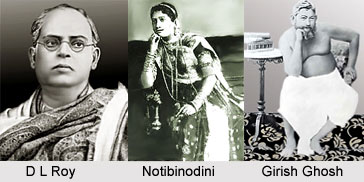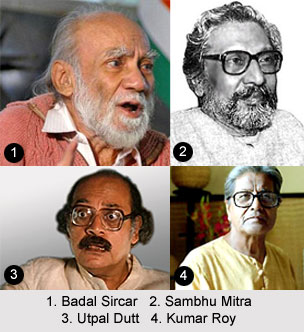 Theatre personalities of West Bengal have played a major role towards popularizing the culture of Indian theatre in the country. With the maturity and progress of the Indian drama, theatre personalities of West Bengal gained much importance and recognition. The coy step which it took long back in the year 1794 with the staging of mainly the translated plays, with time, became, a much sought after art form in illustrating West Bengal or broadly, the then India. The contribution of the eminent theatre personalities of West Bengal is enormous.
Theatre personalities of West Bengal have played a major role towards popularizing the culture of Indian theatre in the country. With the maturity and progress of the Indian drama, theatre personalities of West Bengal gained much importance and recognition. The coy step which it took long back in the year 1794 with the staging of mainly the translated plays, with time, became, a much sought after art form in illustrating West Bengal or broadly, the then India. The contribution of the eminent theatre personalities of West Bengal is enormous.
The history of Bengali theatre begins its journey with Goloknath Das. Later Bengali theatre witnessed much change, and as a result gained a rather contemporary touch with time. Theatre in Bengal continued its journey with the "Kirtivilas" of Yogendra Chandra Gupta, with the `Bhadrarjuna` of Taracharan,`Kulin Kula Sarvaswa` of Ramanarayana Tarkaratna and indeed with the `Neel Darpan` of Dinabandhu Mitra. With the social dramas of Girish Ghosh and then with the historical dramas of Dwijendra Lal Roy, Bengali theatre gained its desired contour whilst marking the beginning of the realistic dramas in Bengal.
The theatre personalities of West Bengal like Shambhu Mitra and Utpal Dutt can be credited in making Bengali theatre a representation of the unaltered realities of daily life and social issues. The extravagance of the song and dance was not there. Theatre then became naturalistic representation of realism. This offered Bengali theatre a thrust whilst injecting a new life into the existing traditions of Bengali theatre. The tradition which was once started by Sisir Kumar Bhaduri and Bijon Bhattacharya was further carried out by other theatre personalities of West Bengal.
The reinvention of the Bengali historical theatre in the true sense of the term was done by the prominent Bengali theatre personality, Dwijendra Lal Roy, in his play "Mebar Patan". Although reckoned as the historical play, it set a bright example of Hindu-Muslim amity.
It was much later the socio political issues like the partition of Bengal 1905, Bengal famine 1943 and the regional socio political scenario started influencing Bengali theatre which gave birth to a new genre- Parallel Theatre. It then became the vehicle of mass education. The famous theatre personality of West Bengal- Ritwik Ghatak, who was the playwright and actor and Bengali film director wrote "Dalil" (The Deed) in 1951 while clearly reflecting the agitation of the people living in East and West Bengal because of the partition.
The trend which started by Ritwik Ghatak was further carried forward by the famous playwright and actor Utpal Dutt., another illustrious theatre personality of West Bengal. He wrote and staged "Itihasher Kathgoray" (On the Derk of History) in 1965 wherein Dutt portrayed plebeian disbelief and that sheer hatred yielded by the outbreak of War between India and Pakistan.
 The legend, the stalwart Shombhu Mitra and his wife Tripti Mitra, another great theatre personality of West Bengal went on to notch many successful productions which further supported Bengali theatre to stand apart in crowd. The group "Bohurupee" which they formed with a number of successful productions like Dashchakra, Raktakarabi, Galilieo, Chand Baniker Pala glorified Bengali theatre.
The legend, the stalwart Shombhu Mitra and his wife Tripti Mitra, another great theatre personality of West Bengal went on to notch many successful productions which further supported Bengali theatre to stand apart in crowd. The group "Bohurupee" which they formed with a number of successful productions like Dashchakra, Raktakarabi, Galilieo, Chand Baniker Pala glorified Bengali theatre.
Ajitesh Bandopadhyay fascinated the Indian audience with his outstanding performance in Bengali plays. The archetypal grandeur of Bengali theatre was again polished and redesigned to befit the then scenario. Badal Sircar, another stalwart, once again with his awesome presentation in "Evam Indrajit" made the Indian psyche to laugh and cry with the play. Theatre by then in Bengal totally became "theatre for the people and theatre by the people".
Just not as the regional theatre, Bengali theatre stood apart as a separate art form to befit the psychological and emotional need of the Indian psyche. Perhaps this is the reason why even Hindi theatre has flourished in Bengal under the likes of Shyamanad Jalan, Pratibha Agarwal and Usha Ganguli.
The works of the prominent theatre personalities of West Bengali thus blossom forth the rich history of Indian theatre, which stands as the portrayal of a journey from the eposes to the contemporary style of naturalistic productions.




